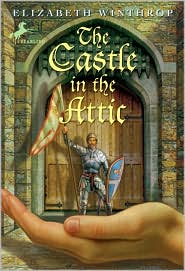Let each of us remember the lesson William has taught us.
The weapons that you need to fight the battle are
inside your own heart.
I read reviews and reviews to try and determine the books that I would choose to read for Fantasy/Science-Fiction, and found Among The Hidden. I still have to blog about that one, but I also chose one that I remembered being a class read-aloud in my fourth grade gifted class - The Castle in the Attic. I remembered the basic plotline - there was a boy, there was a castle, he transported into the castle, he fought the evil guy, and he came out loving his family more than before. However, that's about all I could remember to save my life. I didn't remember the little boy's name, how he got the castle, or any of the remote details of what happened in the land.
Reading this book again allowed me to have fresh perspective on it and realize something crazy - there are so many similarities to The Chronicles of Narnia series, particularly to the first book ("The Lion, The Witch, & The Wardrobe"). So here's a list of the similarities that I could identify - although I'm sure I missed some. Let me know if you've read this book and noticed any that I left out.
- The dark wizard Alastor (assumes a role similar to that of the White Witch) turns people to lead when he is not pleased with them or when they do not follow his instructions; the little boy has the power to turn them back with his touch (similar to Lucy's ability)
- Time is frozen when William is in the castle, just as time is frozen when Peter, Susan, Edmund, and Lucy are in Narnia
- There is a character that leads them through their difficult journey who ends up being turned to stone/lead. In The Castle in the Attic, it is Sir Simon. In Narnia, it is Mr. Tumnus.
- When the dark wizard takes over the kingdom, all of the plants and vegetation stop growing and the crops are not bountiful. This is extremely similar to the disappearance of seasons in Narnia. Once Alastor is defeated, the crops immediately grow again.
- There is a legend in the kingdom that a small boy would accompany Sir Simon to the kingdom to defeat Alastor. There was a legend in Narnia that two Sons of Adam and two Daughters of Eve would defeat the White Witch.
Those are the ones that I could think of and that I noted. Pretty crazy, right? This book was written in 1985, nearly 35 years after The Lion, the Witch, & the Wardrobe was published. I couldn't find any articles or blogs that represented this realization that I had, but I still stand by it!
The Castle in the Attic provides a story that revolves around much of what we discussed with fantasy literature. Children tend to want to escape into fantasy to get rid of the problems they're having in their real lives. William was avoiding the reality that Mrs. Phillips was leaving him, avoiding the reality that his parents were too busy to care about him, and because of that, used the Castle as a way to escape that reality while simultaneously dealing with those issues. Mrs. Phillips was the sort of Aslan character of The Castle in the Attic and served as a person who helped give William the guidance he needed to deal with all of his issues, and overall, grow up and become a better person.
I would definitely have this book in an upper elementary classroom library, and think it would be fascinating as a read-aloud in classes. It is no comparison to The Lion, the Witch, & the Wardrobe, but it modernizes and makes a little less confusing a common store of love, fantasy, and family.

No comments:
Post a Comment